- All You Need to Know
- Home
- Kegel exercises
Kegel exercises
The Kegel exercises help maintain the health of the deep pelvic floor muscles, improving the stability of the pelvis as well as the organs therein. Good tone prevents incontinence and improves sexual performance.
These exercises are a simple way of strengthening the vital pelvic-floor muscles.
Normal posture of the pelvis is vital, not only for the spine, which has the sacrum as its foundation, but also for the support of the internal organs of the pelvis. The most important muscles of the pelvic "corset" are:
- The abdominal muscles
- The small lumbar extensor muscles, and
- The deep pelvic floor muscles.
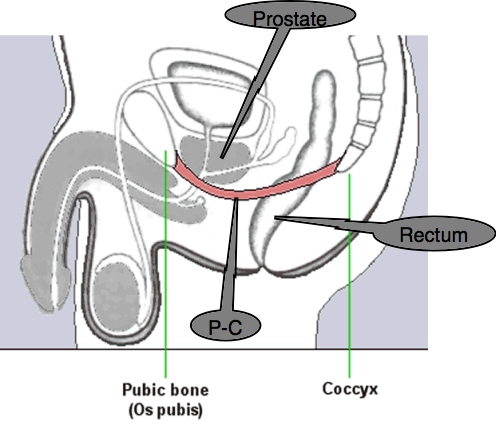
Pubo-Coccygeus (PC) muscle
There are nine different muscles belonging to the deep floor of the pelvis, most note-worthy of which is the Pubo-coccygeus (PC).
It is slung like a hammock from the pubic bones in the front to the coccyx at the back. Notice that in the male the prostate rests on the PC, and the urethra must penetrate through a small hole in the muscle.
They stretch from the pubic bones in the front, sideways to the ilium and backwards to the sacrum and coccyx, hitching onto these bones.
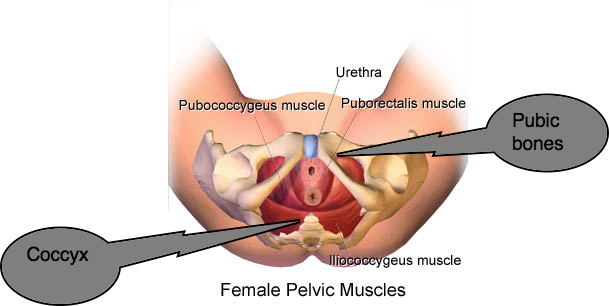
Again, can you see the "hammock'"made up by nine muscles, primarily the PC which stretches from the pubic bones in the front to the coccyx posteriorally?
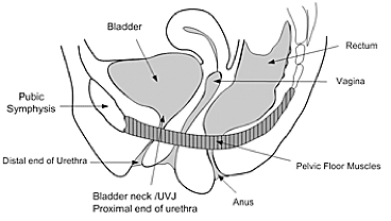
Aside: the coccyx is a vital little bone for the attachments of these muscles. NEVER have it surgically removed. It is quite exposed and prone to injury from direct trauma. This last month a lady with acute back and coccyx pain consulted me after a fall from a horse.
'Fraid I dislike horse riding; it's more dangerous that motor bikes and gliders! They are the third most dangerous animals in South Africa, after humans and bees.
Her coccyx is 50% better after external mobilisation of the coccyx, and a cushion that she made from these plans.
Neck, rib and back pain are almost over with chiropractic help, but that little coccyx is being stubborn. May still have to do an internal though neither of us relish it.
The pelvic "corset" of course is vital for the well-being of the spine, bladder and uterus, but the third, the deep pelvic muscles are the most often neglected. To maintain good posture and healthy internal organs, it is vital that they have continuous, partial contraction (tonus), quite apart from any conscious control.
Note how the vagina and urethra pass through the PC. The healthy muscle promotes greater pleasure in coitus and prevents a leaking bladder during and after pregnancy, and in old age.
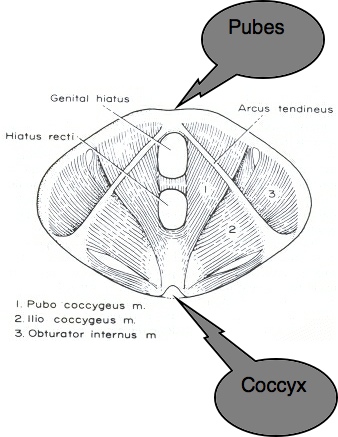
Reflexes
I’m sure you are aware that when your chiropractor tests to see whether the nerve circuits in your leg are intact - by tapping on a tendon, for example just below the kneecap - that the Quadriceps muscle responds automatically, tightening in an unconscious manner, and making your foot shoot forward. It is very important that the body responds immediately in this way if any sudden demand is placed on a muscle.
A healthy PC muscle behaves similarly, able to contract spontaneously and clamp the urethra closed, preventing any leakage when a woman goes jogging for example. It acts in exactly the same way in the male, preventing premature ejaculation, and increasing his and his partner's pleasure. In women, if these muscles are weak then the bladder, uterus and even the bowels could drop down pressing onto the vagina and contributing to urinary incontinence, a horrid and embarrassing, and largely preventable, condition. Hence the need for the Kegel exercises.
Chronic Pelvic Pain Syndrome = Non-Bacterial Prostatitis
Numerous medical groups have suggested that this annoying and painful male condition, often thought to eminate from an infection of the prostate gland, but known not to respond to anti-biotics, is in fact an abnormal pelvic muscle spasm.
Trigger points in these muscles are a major cause of prostate pain in men. Whilst there is much relief to be had from intra-rectal cross-friction of the deep pelvic floor muscles and the prostate itself, it is obviously an awkward procedure, and the Kegel exercises are a better preliminary treatment.
The NIH did some very interesting research on a group of men whose doctors had typically attributed their pelvic pain to a prostatitis infection. By intrarectal examination they assessed the pain and tenderness in the deep pelvic muscles:
41% had pain in the prostate gland itself, but in 27% the pain was in the deep pelvic muscles.
Phytosterols
Fascinating and conclusive research now concludes that a group of substances in plants (sitosterol is the one mainly used) make a VITAL contribution to benign prostate conditions.
Chiropractic Help Treatment
Every chiropractor, and medical doctor, is trained to examine the prostate muscle. There remains debate: is this a 'medical' condition? If the prostate is involved, then yes, probably. But if trigger points in the PC are the culprit (just the same, say as in a tennis elbow ) then your chiropractor is the expert who should be treating this condition.
In practice? Neither medical doctors, nor chiropractors frequently do the required simple, basic, relieving cross friction of the prostate and pelvic floor muscles. Medical doctors give anti-biotics that research proves don't help, and most men find it too awkward to mention to their chiropractor, or don't realise that chiropractic help is available.
Frankly, I too don't do this procedure (it's simple, quick, largely painless, but unpleasant for doctor and patient) unless asked to by a patient. Not many ask perhaps, but there are a good many men out there suffering unnecessarily.
So the Kegel exercises are perhaps a better option. If they do not work, then talk to your chiropractor if you have "prostate" pain that is not responding to your doctor's treatment.
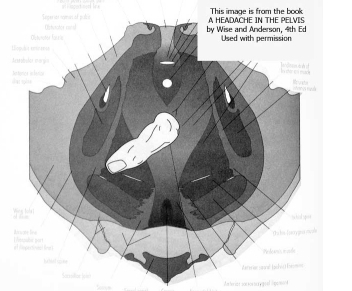
Intercourse
The Kegel exercises are beneficial to both sexes increasing the pleasure of sexual intercourse, by helping men not ejaculate too soon, and women to tighten the vagina, enabling them both to reach a more fulfilling and better timed climax.
Pregnancy
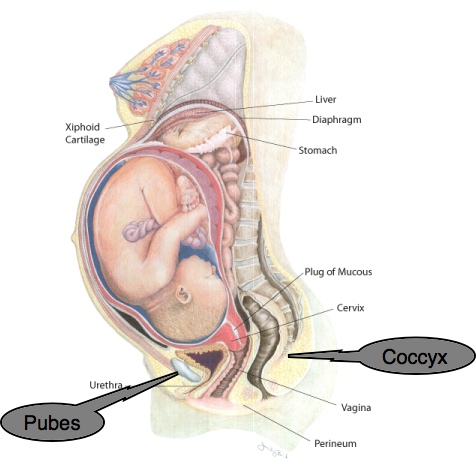
See where the 'sling' would run from the pubic bones to the coccyx?
There is special benefit from the Kegel exercises during pregnancy which places great strain on the pelvis in general, causing pain in the
- sacroiliac joint anatomy
- pubic bone pain
- groin pain, but a Maignes syndrome should also be considered.
and of course urine leakage. They are simple and quite safe. Aside: Did you know that taking post menopausal hormone treatment increases the risks of incontinence? And of course cancer, early dementia and a host of other diseases. Rather walk regularly and take vitamin D rich food and supplements like fatty fish.
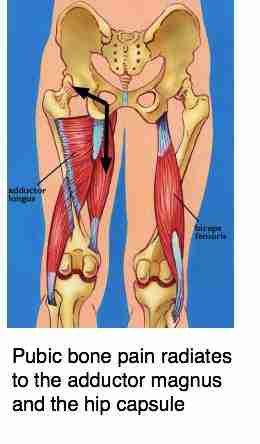
Uterine and/or Bladder Prolapse
If you don't exercise the deep pelvic muscles the chances of the bladder or uterus dropping into a lower position is much greater. There will be pressure against the vaginal wall making sex painful, together with lower back and sometimes groin pain, and a discomfort bloated feeling in the lower abdoman. Like all things, start your Kegel exercises BEFORE you have a problem... prevention is better than a cure.
How the Kegel exercises are done
The Kegel exercises should not be done when you have a full bladder. But the best way to isolate these muscles is to IMAGINE you are urinating, and are going to stop the stream.
So, lying flat on your back, imagine you are having a sweet pee and you want to stop the flow. Squeeze those deep muscles, and relax them again. That's the Kegel Exercises.
You don’t actually stop the urine flow obviously. (Don't do them on the loo, literally stopping the flow. That's bad.)
You should feel the pelvic floor rising and falling as you contract the deep pelvic muscles, hold for several seconds, and then allow the floor to fall again. Repeat several times.
It’s usually recommended that you do the Kegel exercises lying down, but for my money you can do them just as effectively standing and sitting. Standing in a queue whilst waiting for the bus, when you switch the computer on and are waiting for Windows to wake up, or every time you have a cup of tea.
Do them slowly and rhythmically first, feeling the contraction grow, and reaching a climax, relax. You might then want to repeat the Kegel exercises by doing them really quickly, contracting and releasing in rapid succession.
Best of all, do them first thing in the morning, by lying on your bed and combining the Kegel exercises with a pelvic tilt; the Maigne's Syndrome exercises.
In this beautiful exercise you combine all three muscle groups that constitute the pelvic corset. First thing in the morning, on your bed, and then at night again. Good for the back, great for the sagging abs, stop the dripping bladder, wonderful sex, what more can one ask for?! I do them EVERY morning. I mean it! Dinkum.
Unsure that you are contracting the correct muscles? Two things you can do:
- Place your hands lightly across the abdoman. During the Kegel exercises you should feel no contraction of the Abs. Now place you hands just above the pubes: contract - you should feel the deep muscles contracting.
- An alternative way for women to be quite sure is to insert a finger into the vagina (wash carefully first!), and then feel if the the deep vaginal muscles are contraction.
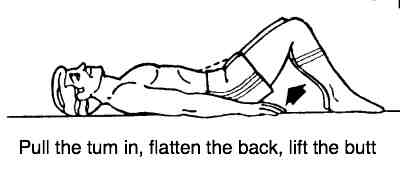
Pelvic tilt exercise incorporating the Kegel exercises
There are three groups of muscles incorporating the "pelvic corset" muscles:
- Oblique abdominal muscles
- Multifidi muscles - small muscles in the back
- Deep pelvic muscles
It's particularly useful to incorporate the Kegel exercises into the Pelvic tilt exercise to build strong "core muscles" - good for the low back, good for the bladder, better sex... See here how the Pelvic tilt can be done incorporating the Kegels...
Anecdotes, true and false
Health is full of anecdotes, some of great value, and others are pure
hogwash. Slowly the scientists are separating the grain from the chaff:
- Yes, an APPLE a day does indeed keep the doctor away.
- No, there's no evidence that shows drinking water will help a headache, nor that you should be drinking eight glasses a day. Nor will it help you lose weight.
- Nope, no research proving that adjusting the Pubic Symphysis will cure Athelete's Foot. ANECDOTE OF THE JAR ...
- Astonishingly, there is research showing that ingesting INTESTINAL WORM OVA helps with the DISEASES OF THE IMMUNE SYSTEM like Ulcerative Colitis and even MS.
- More anecdotes from the CHIROPRACTIC COALFACE ....
One last thought whilst we are discussing the deep pelvic muscles...
Some women get a very deep pain that lies embarrassingly somewhere between the ischium bone, that bone you sit on, and the anus. That pain may well be the female equivalent of the non-bacterial prostatis in men: trigger points deep in the pelvic muscles.
One of those muscles, the Ilio-coccygeus muscle, arises from the ischium and is attached to the coccyx. When all else fails, talk to your chiropractor. Take hubby along if you agree on a course of treatment... that protects both you and your chiropractor. Or ask your gynae if he would examine the area, only he may not understand too much about treating trigger points in a muscle.
My Pilates Exercises - Pelvic floor technique
If you want more exercises for the deep core muscles then this pelvic floor technique expert will give you some great ideas: Pelvic floor technique ...
Hip exercises
These hip exercises combine strengthening the deep pelvic muscles like the pubococcygeus along with the core muscles in and around the pelvic. It's difficult, so it comes in three parts...especially beneficial in this leg pain during pregnancy casefile.
- Go from Kegel Exercises to TOMATO for the PROSTATE gland.
- From deep pelvic muscles to sacroiliac joint treatment
- More Lower back exercises on YouTube ...
- Low Back Pain ...
- Home
- Kegel exercises
When browsing these links use right click and "Open Link in New Tab", or you may get a bad gateway signal.
Did you find this page useful? Then perhaps forward it to a suffering friend. Better still, Tweet or Face Book it.
